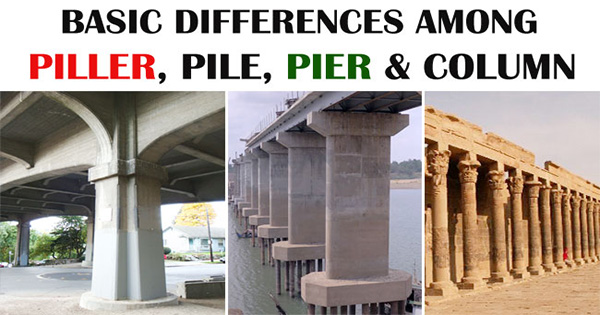Basic differences among Piller, Pile, Pier and Column

This civil engineering article will provide the information on basic differences among piller, pile, pier and column.
Pile - A pile mainly stands for a long cylinder of a sturdy material like concrete that is pressed into the ground to provide a strong support for structures constructed over it.
Pile foundations are effective in the following conditions:-
If a layer of weak soil exists at the surface. This layer is not capable of supporting the weight of the building and for this reason the loads of the building should be circulated through this layer and transmitted to the layer of stronger soil or rock that is situated under the weak layer.
If there is very heavy, concentrated loads in a high rise structure, bridge, or water tank.
Pile foundations have the strength to bear greater loads as compared to spread footings.
Pier – Pier belongs to vertical load bearing member like an intermediary support for adjoining ends of two bridge spans. In foundations of large buildings, piers normally stand for cylindrical concrete shafts, cast in arranged holes, whereas in bridges they capture the shape of caissons, which enter into exact position. The functionality of Piers is identical with piles but they are not set up with hammers and, if dependent on a stable substrate, will accommodate a higher load as compared to a pile.
Piers are not applied to support any horizontal members like beams dissimilar columns. It is also applied specifically for a solid wall so as to differentiate from columns. The piers are primarily utilized to provide support to long walls of forts and they require more floor areas as compared to columns and wide at its base. The pier employs their shear mechanism to withstand the lateral forces. It is erected to the wall at some spacing to provide support to the walls.
Columns - It's mainly utilized to provide support to beams and slabs. The purpose of the columns is to bear the load and retain the integrity of the structure. The column withstands flexural action. It is built up among the walls (corner of walls) to resist the buckling effect. Normally, it belongs to concrete structure.
Piller -A pillar refers to a vertical support member and erected similar to single piece of timber, concrete or steel, or constructed with bricks, blocks and so on. A pillar may contain a load-bearing or stabilizing function but it may also be used as an ornamental element, like a commemorative pillar, or to retain consistency.
However, a pillar does not essentially contain a load-bearing function whereas a column stands for a vertical structural member that is created to transmit a compressive load.

